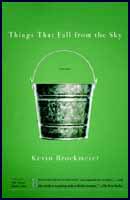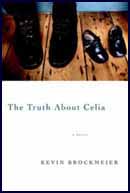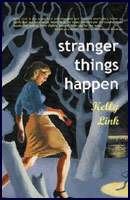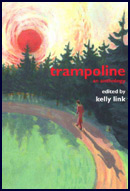Moved Permanently
The document has moved here.
Have Pen, Will Travel: The Fiction of Kevin Brockmeier and Kelly Link
When I'm asked for good examples of border–crossing fiction, the works of Kevin Brockmeier and Kelly Link immediately leap to mind. These two writers wander freely through the varied countries of domestic realism, magical realism, mystery, suspense, romance, ghost stories, myth, fairy tales, and children's fiction...returning with passports filled with stamps and collections filled with dazzling stories. In addition to literary wanderlust, there are other traits Brockmeier and Link have in common. Both are stylists who combine a pitch–perfect ear for the cadences of language with a sly, playful approach to elements of structure and plot. Both work unabashedly with the themes of love and loss, eschewing the detached, cynically ironic pose that passes for hip these days to write stories fully engaged with the passions that underscore the quietest of lives. Even at their darkest, or most whimsical, or most experimental, stories by Link and Brockmeier are marked by their emotional eloquence; these are writers who are unafraid of delving deep into the regions of the heart. The line between traditional and postmodern storytelling is another border these writers simply ignore, creating works that fuse elements of both, creating tales simultaneously old and new, familiar and utterly fresh.
Kevin Brockmeier
Kevin Brockmeier's work has been published in The New Yorker, McSweeney's, The Carolina Quarterly, and The Georgia Review, among other publications, and eleven stories have been collected in Things That Fall From the Sky (Pantheon, 2002). Among the offerings in this fine collection: The Ceiling is a disturbing story about the slow collapse of a marriage, oppressed by the weight of its history as much as by the mysterious object that hovers just overhead. The narrator of the award–winning story These Hands is a man romantically infatuated with an 18–month–old girl. "If I could, I would work my way backwards," he tells us, "paring away the years. I would reel my life around the wheel of this longing like so much loose wire. I would heave myself past adolescence and boyhood, past infancy and birth, into the first thin parcel of my flesh and the frail white trellis of my bones." In The House at the End of the World, a young girl reflects on the period of time her father kept her hidden in a shack in the woods. "This was during the collapse of civilization," the child recalls, "and I believed we were the only people in the world." The Passenger takes place in a mysterious universe encompassed by the interior of an airplane. "My mother gave birth without benefit of midwife," the story begins. "...My newborn body, dangling umbilically above a pool of broken water, floating for a moment between one fact and another, found itself drawing breath — discrete, unanchored, and folded to her shoulder. By this window she released me to this world, and seated here I have spent my days." The most inventive story in the collection is A Day in the Life of Half of Rumplestiltskin, which follows the fairytale figure after the point in which he's spit himself in two. One part of Rumplestiltskin ends up in America, where he receives fragments of letters from his missing half: "Sometimes I wonder when and how it all turned out so _______________ (adjective expressing disconsolation). When you get the chance, _______________ (direction) your half of this _______________ (word that rhymes with better) to me, so I can find out what I've written."
Brockmeier makes deft use of the imagery of dreams, ghost stories, and fairy tales, yet these are narratives firmly grounded in the ordinary details of everyday life. We see this again in Brockemeier's The Brief History of the Dead, published in the September 8, 2003 issue of The New Yorker magazine. It's a powerful meditation on the nature of death, and the things that make life worth living. "Occasionally," he writes, "one of the dead, someone who had just completed the crossing, would mistake the city for Heaven. It was a misunderstanding that never persisted for long. What kind of Heaven had the blasting sound of garbage trucks in the morning, and chewing gum on the pavement, and the smell of fish rotting by the river? What kind of Hell, for that matter, had bakeries and dogwood trees and perfect blue days that made the hairs on the back of your neck rise on end? No, the city was not Heaven, and it was not Hell, and it certainly was not the world. It stood to reason, then, that it had to be something else. More and more people came to adopt the theory that it was an extension of life itself — a sort of outer room — and that they would remain there only so long as they endured in living memory. When the last person who had actually known them died, they would pass over into whatever came next..."
As good as Brockmeier's stories are, his first novel for adults is even better. The Truth about Celia is the story of Christopher Brooks, a science fiction writer whose seven–year–old daughter simply disappears as she's playing in the yard one day. The novel is formed by interlinked stories written by Brooks in the aftermath of this tragedy. (Brockmeier includes an Author's Note about Brooks, and a list of his invented writer's publications.) The text by Brooks/Brockmeier tells the story of young Celia's disappearance, and the subsequent dissolution of her parents' marriage. The text also contains a book–within–a–book: a beautiful re–working of the English folktale The Green Children: "They say I was the first to touch them. When the reapers found the children in the wolf pits — a boy and a girl, their skin the pale flat green of wilting grass — they shuddered and would not lay hands on them, prodding them across the fields with the handles of their scythes." Weaving these various strands together, playing with multiple layers of reality, Brockmeier tells a painful story of love and devastation that is also surprisingly uplifting.
Brockmeier has received the Nelson Algren Award, the Italo Calvino Award, a James Mitchner–Paul Engle Fellowship and two O'Henry Awards. His work has been selected for The Best American Short Stories and The Year's Best Fantasy & Horror; and his story The Brief History of the Dead is being made into a film. He has also published a children's novel, The City of Names (Viking, 2002). You can read the following stories by Kevin Brockmeier on line: The Brief History of the Dead, The Green Children (excerpted from The Truth About Celia), and the award winning The Ceiling.
Kelly Link
Kelly Link's work has been published in McSweeney's, Conjunctions, Asimovs, Century, Realms of Fantasy, The Vintage Book of Amnesia, and The Dark, among other publications, and eleven of her tales have been collected in Stranger Things Happen (Small Beer Press, 2001). The offerings in this debut collection include two award–winners, The Specialist's Hat and Travels With the Snow Queen. The first is a dark, mesmerizing tale about twin sisters obsessed by death. Link writes: "When she has time to think about it (and now she has all the time in the world to think) Samantha realizes with a small pang that she is now stuck indefinitely between ten and eleven years old....The number 10 is pleasing and round, like a beach ball, but all in all, it hasn't been an easy year. She wonders what 11 would have been like. Sharper, like needles maybe. She has chosen to be Dead, instead. She hopes that she's made the right decision. She wonders if her mother would have decided to be Dead, instead of dead, if she could have." Travels With the Snow Queen is a skillful feminist deconstruction of the Hans Christian Andersen fairy tale, and several other fairy tales besides. "At the top of the staircase is a wooden door with a silver keyhole. The dreams pour steadily through the keyhole, and under the bottom of the door, and when you open it, the sweet stink and cloud of dreams are so thick in the Princess's bedroom that you can barely breathe. Some people might mistake the scent of the Princess's dreams for the scent of sex; then again, some people mistake sex for love." Louise's Ghost is the story of the friendship between two women, and of the ghost who appears to one of them. At one point, the ghost goes missing, and Louise scours the house looking for him. "She finds the ghost curled up in her underwear drawer. He lies face down, hands open and loose. He's naked and downy all over like a baby monkey. Louise spits on the floor, feeling relieved. 'In God's name,' she says, 'what do you want?' The ghost doesn't say anything. He lies there, small and hairy and forlorn, face down in her underwear. Maybe he doesn't know what he wants any more than she does."
Link's specialty is to take genre expectations and turn them upside–down and inside–out. She does this with the tropes of supernatural fiction in Louise's Ghost, with those of romance fiction in Travels With the Snow Queen, and with those of Nancy–Drew style mysteries in The Girl Detective — a story that ranks as one of the best examples of interstitial fiction I've yet read. "I myself was the girl detective's lover for three happy months. We met every Thursday in a friend's summer cottage beside a small lake. She introduced herself as Pomegranate Buhm. I was besotted with her, her long legs so pale they looked like two slices of moonlight. I loved her size 11 feet, her black hair that always smelled like grapefruit. When we made love, she stuck her chewing gum on the headboard. Her underwear was embroidered with the day of the week. We always met on Thursdays, as I have said, but according to her underwear, we also met on Saturdays, on Wednesdays, on Mondays, Tuesdays, and once, memorably, on a Friday. That Friday, or rather that Thursday, she had a tattoo of a grandfather clock beneath her right breast. I licked it, surreptitiously, but it didn't come off. The previous Thursday (Monday according to her underwear) it had been under her left breast. I think I began to suspect then, although I said nothing and neither did she."
Link's themes, like Brockmeier's, center on love and loss, on people who have vanished, and on the various kinds of ghosts that haunt our daily lives. "I like the idea of taking things that are alien and making them seem really very cozy and familiar," she says. "That's something that science fiction can do. It's the way that people can look at pictures of flying saucers and say that looks like a saucer, from under a teacup, something small and domestic. On the other hand, what I like about more realistic fiction, writers like Lorrie Moore, for example, is the way it looks at familiar things and makes them seem so strange. What I hope to do is to mix those up, so that you're constantly feeling comfortable and unsettled at the same time."
Link's fiction for children is also worth seeking out, for it is equally unique and utterly charming. Swans, published in A Wolf at the Door (Simon & Schuster, 2000) is a heady reworking of the Wild Swans fairy tale, and The Faery Handbag, published in The Faery Reel (Viking 2004), is the hilarious story of a teenage girl, her grandmother, and an enchanted furry purse from Baldeziwurlekistan. "Baldeziwurlekistan is where Zofia was born, over two hundred years ago. (My grandmother claimed to be over two hundred years old. Or maybe even older. Sometimes she claimed that she'd even met Genghis Khan. He was much shorter than her. I probably don't have time to tell that story.) Baldeziwurlekistan is also an incredibly valuable word in Scrabble points, even though it doesn't exactly fit on the board."
Kelly Link is also an anthology editor, and co–publisher of Small Beer Press with her husband Gavin J. Grant. In these roles, she champions the work of other border–crossing writers from a variety of fields. Her recent anthology Trampoline (Small Beer Press, 2003) contains "twenty–four astounding stories" by a mix of genre, mainstream, and interstitial writers, and the Small Beer Press 'zine, Lady Churchill's Rosebud Wristlet, regularly showcases works of cutting–edge, hard–to–categorize fiction by both established and emerging writers. In addition, Link and Grant have recently been named as co–editors, with Ellen Datlow, of the annual Year's Best Fantasy & Horror volumes from St. Martin Press.
Link has won the Tiptree Award, the Nebula Award, the World Fantasy Award, and the Stoker Award. Stranger Things Happen was listed as a Best of 2001 title by The Village Voice, The San Francisco Chronicle, and Salon magazine; and Link's story The Girl Detective inspired a play of the same title, staged by the Invisible Cities theater group in Philadelphia. You can read Laura Miller's interview with Link on the Salon magazine web site, and more information on the author is available at www.kellylink.net. You can read the following stories by Kelly Link on line: Most of My Friends are Two–Thirds Water, Carnation, Lily, Lily, Rose, and Survivor's Ball, (or, the Donner Party). You can hear an audio file of Link reading Catskin on the WNYC web site.
Contributor's notes
Terri Windling is an author, artist, and editor of the online journal Endicott's Journal For Mythic Arts.





